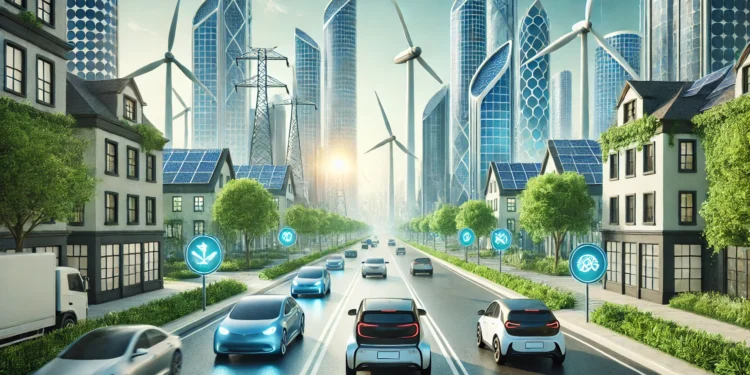As global energy consumption rises, high-energy sectors—such as data centers, manufacturing, and heavy industries—are coming under increasing pressure to reduce their environmental footprint. While the demand for energy-intensive services continues to grow, companies in this space are finding innovative ways to balance operational needs with sustainability goals. Public and private sector collaborations are leading the charge toward renewable energy integration and energy efficiency.
The Energy Dilemma for High-Energy Sectors
In industries like cloud computing, telecommunications, and manufacturing, energy consumption is not just a significant cost—it’s also an environmental challenge. The rise of cloud services and AI-driven technologies has pushed energy demands to unprecedented levels. According to the International Energy Agency (IEA), data centers alone are expected to account for around 3% of global electricity demand by 2030.
But there’s good news: the public and private sectors are actively addressing these challenges through innovative solutions in energy procurement, advanced infrastructure, and green energy investments. Companies are no longer just focusing on energy efficiency as a cost-cutting measure but are embracing it as a core part of their sustainability strategy.
Leading the Way: Key Companies in the High-Energy Space
Pacifico Energy is a prime example of how a private company is changing the game by powering high-energy users—such as data centers and heavy industries—with renewable energy solutions. With a growing focus on solar, wind, and advanced storage technologies, Pacifico is providing scalable, green energy solutions that allow energy-hungry industries to operate sustainably without sacrificing performance.
🌱 Discover how Pacifico Energy is transforming the energy landscape by visiting www.pacificoenergy.com.
But Pacifico isn’t alone. Public and private sector companies, large and small, are joining forces to tackle the energy challenge head-on:
- Equinix, one of the world’s largest providers of data center services, is powering its global network with 100% renewable energy, setting a gold standard for how the tech industry can reduce its environmental footprint.
- Vistra, a major energy provider, has committed to reducing carbon emissions by 25% by 2030, focusing on renewable energy generation and carbon capture technologies.
- Digital Realty has implemented cutting-edge energy-efficient technologies to reduce the power usage effectiveness (PUE) of its data centers, setting the bar for sustainable data storage globally.
- Microsoft, in partnership with power companies, is accelerating the transition to carbon-free energy solutions for its global operations, aiming for net-zero emissions by 2030.
The Role of Public-Private Collaborations
As high-energy users are scrutinized for their environmental impact, public-private partnerships (PPPs) have become a cornerstone of the solution. These collaborations are critical in scaling green energy infrastructure and ensuring that large industries can meet both their operational goals and sustainability targets. The public sector is offering incentives and subsidies to companies willing to integrate renewable energy into their business models, while the private sector brings the technological innovation necessary to scale these efforts.
In sectors like telecommunications, data storage, and cloud computing, large corporations are also collaborating with local governments to invest in smart grid technologies, on-site renewable energy systems, and energy storage solutions that reduce dependence on the grid and increase reliability.
Tech-Driven Solutions: From Energy Efficiency to Sustainability
As energy costs continue to rise, more companies are turning to AI and machine learning to optimize energy usage in real-time. For high-energy sectors like data centers, these technologies are proving invaluable in reducing power consumption without compromising performance. AI-powered energy management systems allow companies to predict energy needs, adjust consumption patterns, and shift to renewable sources when possible.
Meanwhile, advanced cooling technologies, such as liquid cooling systems and free cooling, are drastically improving energy efficiency in data centers, cutting costs and emissions. In some cases, new server designs allow for heat recovery, where excess energy is captured and reused in other parts of the facility.
Stats You Should Know:
- Equinix: Over 60% of Equinix’s energy comes from renewable sources, and they plan to reach 100% by 2030. They are also committed to reducing their carbon footprint by 50% by 2030.
- Vistra Energy: Vistra plans to generate 90% of its energy from clean sources by 2030, with an emphasis on solar, wind, and storage.
- Digital Realty: Reduced its PUE by 20% in the last five years, marking significant progress in energy efficiency.
- Microsoft: Achieved a 35% reduction in carbon emissions per unit of compute power over the last five years. The company is targeting net-zero emissions by 2030 and aims to be carbon negative by 2050.
Why This Matters for Investors
Investing in high-energy users that are making the transition to renewable energy is not just a moral imperative—it’s a smart business move. Companies that prioritize energy efficiency and sustainability are positioned for long-term growth, benefiting from both operational cost savings and stronger public relations.
Additionally, with the global push toward net-zero emissions, governments are incentivizing green energy initiatives, creating an even more lucrative environment for companies that invest in sustainable infrastructure. As more tech companies and energy providers move toward green solutions, investors who back these companies will see their portfolios benefit from early-stage involvement in the green energy revolution.
Call to Action: Get Involved
If you’re looking to take your investment strategy to the next level, now is the time to look into companies at the forefront of sustainable infrastructure. Want to dive deeper into the latest trends in data centers and high-energy sectors? Would you like me to help you find specific stock details, earnings reports, or market analysis for companies like Equinix, Digital Realty, or Vistra?





















